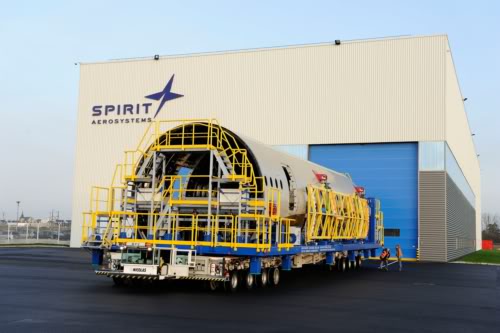Bonsoir !
La fabrication du A350 en Espagne !
Une revue de composites World , dans la même ligne que plus haut !
Peut être un peu moins de techno quand même !
Un long extrait pour l'unité Airbus de Illescas, proches d'un centre de production Hexcel en plus !
Des méthodes de production avancées et parfois originales, et ça tourne 24x7 !
Une peau inférieure de l'aile est faite pour Broughton, ainsi que des quantités de raidisseurs !
Un long article qui décrit toute la genèse des usines de CFRP modernes en Espagne !
----------- Un extrait des photos, et le lien Composites World, Sara Black ---------
http://www.compositesworld.com/articles/the-plane-in-spain
An Airbus Illescas-designed “turning rack” device, like a barrel with longitudinal slots, approximately 6 ft/1.8m in diameter by 20 ft/6.1m long, is suspended from the ceiling. The rack holds the formed (but uncured) stiffeners in the slots in the correct layup sequence above the worktables. As it rotates it deposits the stiffeners onto the layed-up part skins on the work surfaces, greatly reducing assembly time.
The placed stiffeners are then bagged and cocured with the skins, eliminating a postcure bonding step. As part of the company’s lean and environmentally driven manufacturing, layup technicians use reusable silicone bags for much of the processing, greatly reducing the use of consumables.
Section 19 of the A350, its fuselage tailcone, is produced with a dedicated autoclave in a newer area of the original building. In the tailcone process, a series of “omega” stringers (shaped like the Greek letter “Ω,” with a trapezoidal profile) are produced by an MTorres ATL machine configured with a layup head on one end and an automated ultrasonic cutting head on the other. The ATL head rapidly lays down the material for a group of stringers, nested for minimum waste, to form a prepreg “blanket.” Within seconds, a conveyor shuttles the blanket over to the cutter, which cuts and trims it into the final stringer shapes. The head and cutter operate simultaneously, significantly increasing the ATL’s productivity. The cut stringers are manually carried to a metallic stamping machine that is equipped with the appropriate tool. The parts are formed then placed into the longitudinal recesses around the circumference of the Section 19 aluminum mandrel tool so the stringers are flush with the tool’s surface. Rubber inserts are placed within the hollow “hats” of each stringer to apply consolidation pressure, and they are bagged and vacuum-consolidated. Then a MAG Cincinnati (Hebron, Ky.) AFP machine automatically lays up the skin over the prepared stringers, and the entire part is bagged and cured in one shot.
After cure and demolding, parts are moved to the trimming machines for processing, then to the automated NDI machine for inspection, before they are prepared for shipping to Airbus final assembly locations, including nearby Getafe; Toulouse, France; and Hamburg, Germany. Says Santos-Gómez, “We have tremendous flexibility here to adapt to the manufacture of the large variety of different composite parts.”
The facility centerpiece, however, is its new A350 lower wingskin production building. Representing an investment of more than €450 million ($637 million USD), the vast space (180,000m2/19.375 million ft2) was designed for a nearly 100 percent automated manufacturing flow, says Santos-Gómez. “This lower wingskin part is quite complex, with a thickness between 6 mm [0.2 inch] and 30 mm [1.15 inches] at the root end.”
Specially designed automated carts transport the wingskin tools, made of Invar by Coast Composites Inc. (Irvine, Calif.), to one of the ATL stations at one end of the building — space is available for eight stations, but at the time of HPC’s visit, one was operational and a second was being prepared. The ATL machines are TORRESLAYUP units. After layup of the 35m/115-ft long skin is complete, it is cured in a huge autoclave manufactured by Dalkia España.
Wing stringer production takes place simultaneously at the opposite side of the room, which is dominated by a huge expanse of stringer tools, a heated press, an MTorres AFP machine and an overhead gantry transport system. The AFP machine rapidly lays fiber tows to create the complex stringers (the longest of which is 35m/115-ft long) in two dimensions to near-net shape, in accordance with a CNC nesting plan that minimizes waste, says Motilva. “We can save a small percentage of carbon prepreg with each stringer, but multiplied by the 25 stringers per wingskin, at 13 aircraft per month, the savings in reduced scrap is dramatic and significantly reduces overall stringer cost.” The massive moving gantry system, with pick-and-place capability, automatically transports each layed-up stringer to its assigned tool, takes the tools to and from the hot press, and then moves the formed stringers to the cured wingskin for application. According to Airbus,
the automated wingskin production process will use more than 800 metric tonnes (1.8 million lb) of carbon fiber annually at the facility’s maximum production rate.After the stringers are applied to the skin and bagged, the wingskin is cured again, then moved to a finishing bay,
where a Flow International Corp. (Kent, Wash.) waterjet system performs necessary trimming while the wingskin is secured in a unique holding fixture. Santos-Gómez says the NDI step that follows is done in one shot because what he calls a “better method” of performing inspection scans significantly increases scanning speed. Additional bays handle the final inspection (and any cosmetic repairs) and painting before preparation for shipping to the U.K. for assembly.
Concludes Santos-Gómez, “
I believe this may be the largest dedicated composites manufacturing plant in the world, and certainly one of the most.
------------
Les panneaux inférieurs des Ailes du A350 ! Noter les qty de Stringers !


JPRS







 !
!










